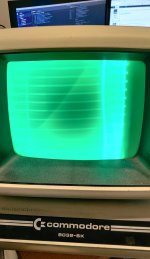Robin Elvin
Member
Hi,
I'm wondering if some PET experts can guide me through diagnosing and repairing a PET 8032 I am trying to fix. When I got the machine it was completely dead which I quickly discovered was due to no 5V supply. That turned out to be caused by both 5V regulators having failed so I replaced them and got the familiar chirp. Now I have no display on the screen except excessive flyback lines. I hooked another PET CRT up to check and it shows the same.
Not being familiar with the PET I have studied the schematics relating to the display and the only thing which I can see that looks possibly wrong to me is RA4 on the 6845 CRT controller seems to have no activity. Since this looks to be OR'd with RA3 to produce 'NO ROW' I would expect something on that pin. I lifted the leg on the CRTC in case something was pulling it low and checked again but there is nothing coming from it. Although, as I said, I'm not familiar with the PET so not sure if this is expected.
Other outputs on the CRTC seem to be ok including vertical drive at 50Hz and horizontal drive at 20kHz and verified at J7. There appears to be a regular 20kHz signal on the video pin 1 of J7 also.
Any help appreciated and I look forward to learning more about the PET.
Thanks
I'm wondering if some PET experts can guide me through diagnosing and repairing a PET 8032 I am trying to fix. When I got the machine it was completely dead which I quickly discovered was due to no 5V supply. That turned out to be caused by both 5V regulators having failed so I replaced them and got the familiar chirp. Now I have no display on the screen except excessive flyback lines. I hooked another PET CRT up to check and it shows the same.
Not being familiar with the PET I have studied the schematics relating to the display and the only thing which I can see that looks possibly wrong to me is RA4 on the 6845 CRT controller seems to have no activity. Since this looks to be OR'd with RA3 to produce 'NO ROW' I would expect something on that pin. I lifted the leg on the CRTC in case something was pulling it low and checked again but there is nothing coming from it. Although, as I said, I'm not familiar with the PET so not sure if this is expected.
Other outputs on the CRTC seem to be ok including vertical drive at 50Hz and horizontal drive at 20kHz and verified at J7. There appears to be a regular 20kHz signal on the video pin 1 of J7 also.
Any help appreciated and I look forward to learning more about the PET.
Thanks

